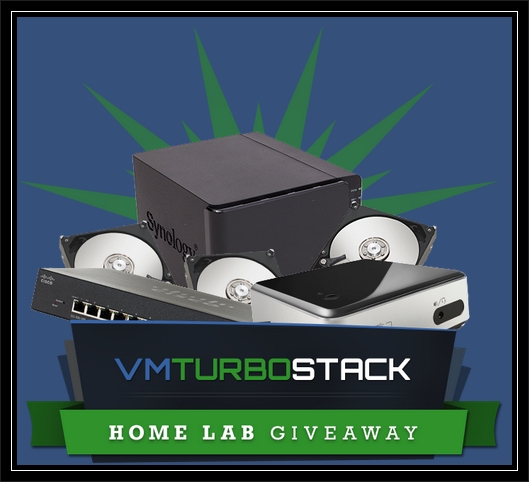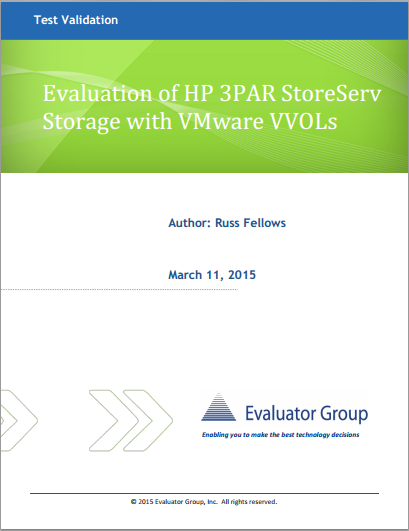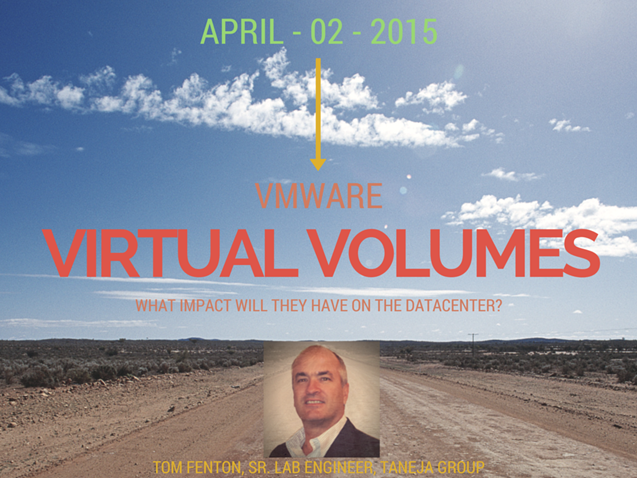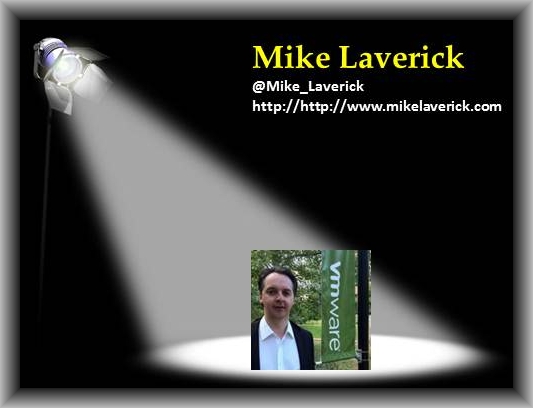Author's posts
Mar 26 2015
VMTurbo is giving away a great home lab just for watching a webinar
Register for the VMTurbo 5.1 Release Webcast and get THREE CHANCES to win a Turbostack Home Lab, valued over USD $1,600.00!
Now I would encourage you to watch the webcast even if they weren’t giving away a pretty cool home lab kit (that’s what they call it in the UK) as VMTurbo makes a great and unique product for vSphere environments. If learning about a great product wasn’t enough, you also have a chance to win something that you can try it out on. Their Turbostack Home Lab includes everything you need to get vSphere up and running including a host, external shared storage and networking to connect it all together. Below is what is included:
- Intel NUC with Intel Core i5-4250U
- G.SKILL Ripjaws Series 16GB (2x8G) 204-Pin DDR3 Memory
- SAMSUNG 840 EVO 250GB SATA III TLC Internal Solid State Drive
- Synology DS415+ Diskless System DiskStation 4-Bay NAS
- 2x Dell 1TB 7200 RPM SATA 3.0Gb/s 3.5″ Hard Drive
- Cisco SG300-10 10-port Gigabit Managed Switch
- Rosewill 7ft. Cat 6 Network Cable
Now if you aren’t familiar with the Intel NUC, it stands for Next Unit of Computing and is designed to fit a lot of computing power in a small little package. This is great for a home lab as it requires very little space and both noise and power consumption (65w) are very low. You can read the specs for this cool little unit here.
The Synology DS415+ is a great mini storage array, I’ve owned a Synology unit and have always been impressed with them. It’s a very versatile unit that supports both iSCSI and NFS protocols and can be used for a variety of things beyond your vSphere lab. It holds up to 4 drives, supports SSDs and up to 24 TB (6 TB HDD X 4) of space.
So what are you waiting for, grab some popcorn and a beer, go watch the webinar, learn about a great product and maybe you walk away with some cool kit.
Mar 25 2015
New paper on VMware Virtual Volumes (VVols) from Evaluator Group
Want to know more about VMware Virtual Volumes (VVols) and get an analyst perspective of this exciting new VMware storage architecture? Well you can, Evaluator Group has a new paper entitled “Evaluation of HP 3PAR StoreServ Storage with VMware VVOLs” that details their experience and opinions after some hands-on experience with VVols running on 3PAR. The paper includes the results of a basic performance comparison that they performed between VM workloads running on VMFS and the same workloads running on VVols.
Mar 25 2015
vBlogger Spotlight: William Lam
While we wait for the Top vBlog results I thought I would shine the spotlight on several prominent bloggers in the community to give you some insight into their experiences with blogging. Today’s spotlight is on William Lam, automation wizard extraordinaire and voted last year as the #2 vBlogger in the world. Let’s face it we all have a lazy side and automation makes an admins job so much easier. Thanks to William and his great tips and scripts we can all become big fat lazy vSphere admins. After all wouldn’t we rather be working smarter than working harder and the great content that William posts on his Virtually Ghetto blog makes that possible. William debuted at the #25 spot in the 2011 Top vBlog voting and quickly moved up into the top 10 in 2012 before rising to #2 last year. William is also a genius when it comes to nesting ESXi and getting ESXi to run on a Mac Mini to help out all those home labs out there. So without further ado enjoy a Q&A session with William Lam:
What year did you start your blog?
[William] virtuallyGhetto was started in 2010
What inspired you to start a blog?
[William] In the early days when I was a system administrator, I spent quite a bit of time on the VMTN Community Forums helping answer questions related to VMware automation and scripting. As part of my day job, I did a lot of Automation and I found that many of the questions that were being asked were things that I had done before or things that I was currently working on. I figured that I could help others by sharing some of the solutions and experiences that I had so that the greater community could benefit overall. With my replies, I usually ended up providing a fully functional script that exercised the task or operation so the OP gets the information they needed but also got a working example so that it helps them out in their current situation. All of this was done on the VMTN Community forum and some static HTML pages that I was manually updating which kept track of all the scripts that I had written. As you can probably guess, this made searching and notifications of new content pretty challenging.
I eventually decided to start a blog after multiple comments from my friend Duncan Epping who really encouraged me to give this blogging thing a try. He had always been a mentor/supporter of my content and had even blogged about my scripts on more than several occasions. I figured by having a blog, I could make it easier for people to search for solutions to their questions and help foster a community around VMware automation and scripting which did not really exist back then.
Describe your early blogging experiences and how you have evolved over the years?
[William] I had initially only focused on vSphere Automation as a topic for my blog. However, being a technologist and loving to learn about new things and solving problems I quickly expanded beyond just vSphere Automation. I started to explore other areas and products in VMware’s portfolio such as storage, networking and management. Other popular topics that I have been writing about are Nested Virtualization, Mac Mini for home labs and just doing cool and sometimes not supported things with VMware products. I definitely enjoy variety and you can see that with the content over the years.
What has kept you blogging over the years and not quitting at it?
[William] For me personally, it is the continue sharing of information with the community and the constant learning of new things that really keeps me going. I really enjoy learning about new technologies and in turn I can share that knowledge which can help someone solve a problem. You get this circular effect that only makes our community stronger.
What was your best experience or fondest memory related to blogging?
[William] Honestly, there are so many it is hard to just pick one. For me, the best experience I could get from blogging is just a simple note from a reader saying how one of my articles or a script has helped them solve a particular problem. I really do enjoy reading those emails and makes it all worth it at the end. I guess a nice runner up is hearing from VMware Engineering and GSS Support that they use several of my blog articles on a regular basis 🙂
Any advice for others who are new to blogging?
[William] Do not start a blog to just start a blog. Write about something that you are very passionate about. There are still so many topics within the VMware and Virtualization community that have been unexplored in great detail, try to really differentiate yourself from what others have already done. Lastly, it is all about the content! The more unique and interesting content that you can produce the larger the reward in terms of readership, engagement and longevity of blogging.
Mar 24 2015
VMworld 2015 Call for Papers now open!
It’s that time of year again, time to submit your best session ideas for VMworld for that oh so slight chance that it might get accepted. Below are the timelines for the whole CFP process.
- Call For Papers opens March 24, closes April 28
- June 12 (+/- a few days) Speaker Resource Center opens
- June 23 Content Catalog goes live
- July 14 (August 18 in Europe) Schedule Builder launches
- 2 weeks prior to each show room assignments are announced
And of course some tips for making the best possible submission. From previous experience I can tell you to have a catchy title as it’s your sessions curb appeal. Many people won’t make it past your title and you miss a chance to interest them with your abstract if you have a boring and un-interesting session title. As a former content committee judge I can also tell you to spend some time on your abstract and don’t rush to throw something together without thinking it through. I’ve seen lots of session proposals that lacked any real detail about what the session was about. Here are some additional tips that VMware provides:
Tips for Creating Effective Titles for Submission
- Do not use abbreviations or acronyms under any circumstances in the titles of your submissions.
- Do not use competitor or other company names in your submission titles. If you are highlighting other companies within your session, you can adopt these names within the session description.
- Start with the Benefit: Ex: Shorten Adoption Time by Using VMware’s XXX.
- Use clear and concise language that attendees will immediately understand. The agenda will eventually host hundreds of sessions and attendees need to easily identify sessions of interest. Straight forward language like “Introduction to”, “Deep Dive” and “Case Study” are popular examples because they quickly tell the attendee important information about the session.
Typical Reasons for Abstract Rejection
- The abstract is poorly written—ideas are not clear, goals are not established, there are grammatical errors, etc.
- The content is not relevant to the indicated audience.
- The session value is not clearly identified.
- The session topic is not unique or overlaps with another more appropriate abstract.
Tips for Writing Winning Abstracts
- Avoid beginning your session description with the phrase, “In this session we will…”, or “In this session you will learn…”. It does not add value and becomes tedious on an agenda of several hundred sessions. Instead try a rhetorical question, or an interesting industry data
point to start your session abstract. - Ensure that what you submit will be what you present. Nothing will upset attendees more than signing up for a session that is not what it is advertised to be.
- Your abstract should generate enthusiasm‐ make sure your content is relevant, but also generates excitement. What invaluable information will be shared during the session?
- Thoughtfully leverage the tags in the system for topics, level, and roles. Who is the target audience? What products or topics does this session cover outside of the track name? What roles would specifically benefit from this session? Do not check every check box if your session is applicable to all.
- Be Original – Attendees want to see new presentations that cover the latest innovations in technology. Take the time to create well‐written titles, abstracts, outlines, and the key takeaways for your submission. A thoughtful proposal will have a better chance of being
selected and if accepted, will be seen by thousands of attendees once published in the course catalog. - Be Educational –VMware requires that sessions focus on the educational value of the presentation. Be sure that your proposal doesn’t sound like a sales pitch but rather an exciting opportunity for attendees to learn something new.
- Be Timely – Make sure your topic is relevant to the audience you’re targeting. Review the content topics before submitting a session.
Mar 24 2015
Upcoming round-table panel discussion on Virtual Volumes (VVols) hosted by Taneja Group
I’ll be participating as one of the panelists in an upcoming round-table discussion on Virtual Volumes (VVols) that is being hosted by Tom Fenton of the Taneja Group. Click the image below to sign-up and hope to see you there.
VMware Virtual Volumes – What impact will they have on the datacenter?
Thursday, April 2nd at 9:00 am PST
Join us for a fast-paced and informative 60-minute roundtable as we discuss one of the hottest topics in the datacenter: VMware vSphere Virtual Volumes (VVOLs). VVOLs is the industry’s first solution to enable native virtual machine-awareness across a broad range of SAN/NAS arrays. VVOLs will be packaged as a feature in VMware vSphere Standard Edition and above as well as in VMware vSphere ROBO editions, and is seeing a groundswell of interest from IT professionals, especially those involved in datacenter operations. The panel includes VVOL experts from four major vendors that have announced they will be implementing VVOLs into their storage. Some of the questions we will be asking them include: What immediate impact will VVOLs have on the datacenter? What should the early adopters look for in a VVOL-based storage solution? Should datacenters start to implement VVOLs right away or wait for VVOL.next?
Mar 23 2015
When it comes to implementing Virtual Volumes (VVols) you better be on time
I was conversing with one of our VVol engineers today after he mentioned that we have seen customers experiencing problems with using VVols due to time sync issues in their vSphere environment. These problems could of easily been avoided with some simple RTFMing.
VMware’s New Virtual Volumes (VVols) architecture has a lot of moving parts and one big requirement for those parts to all work together is to have time synced between them. The below diagram depicts the vSphere components that are part of the VASA 2.0 specification which defines vendor VVol implementations.
The vSphere 6 storage documentation states the following before implementing VVols:
- Synchronize all components in the storage array with vCenter Server and all ESXi hosts. Use Network
Time Protocol (NTP) to do this synchronization.
That means you must synchronize time across the same NTP source with every ESXi host that will use VVols, your vCenter Server, your storage array and your VASA Provider if its external and not built into the array. You might think that this is no big deal if you don’t do this but that’s not the case, here’s some scenarios where it will cause problems:
- During the initial setup of VVols if the time between your vCenter Server and storage array are out of sync when you try and register your VASA Provider it will fail with a cryptic error message which won’t indicate that the failure was caused by time not being in sync..
- Once you register your VASA Provider and try and use VVols if your ESXi hosts are out of sync as well you may not be able to create a VM on VVol storage. What could occur in this scenario is that the VVol datastore reports zero space available so you are unable to select it as storage device when creating a new VM. Again not something that you would attribute to time being out of sync.
There may very well be more issues with using VVols that occur due to time not being in sync between all components. There are also time stamps that are used with VVols that could potentially cause problems if the time is off. These issues may all not be obviously related to time so to save yourself from potential problems and troubleshooting just make sure you have all your clocks in sync.
Mar 19 2015
vBlogger Spotlight: Mike Laverick
While we wait for the Top vBlog results I thought I would shine the spotlight on several prominent bloggers in the community to give you some insight into their experiences with blogging. Today’s spotlight is on Mike Laverick, one of the OG bloggers who started his RTFM (Read The Frigging Manual) Education website way back in the early days of blogging. Mike was also one of the early book authors as a member of the Advanced Technical Design Guide rat pack that authored some of the first books on virtualization. Mike is the host of the Chinwag podcasts where he uses his laidback, informal interview style to chat with guests about virtualization. A former Certified VMware Instructor, Mike’s great passion for teaching and helping others is evidenced by his blog posts, articles, books, podcasts and his unselfish eagerness to share and give back to the community. So without further ado enjoy a Q&A session with Mike Laverick:
What year did you start your blog?
[Mike] RTFM Education started in 2003, but I flogged that to TechTarget, so I’m not sure if that really counts anymore! As for mikelaverick.com (such a pithy name dontcha think?) started in Feb, 2013…
What inspired you to start a blog?
[Mike] Back 2003 it was just an honest willingness to share what I learned, and help others. The plans for Dr Evil style world-domination came later…
Describe your early blogging experiences and how you have evolved over the years?
[Mike] I’m going to be a bit vain here. But I would like to my style has influenced others. I read other bloggers and think, “god, that’s just how I would do it”. I don’t feel ripped off, but slightly proud. I told you I was going to be vain! But I like to think my style is one that blends just right of theory with a big dollop of “getting it done”. My most popular posts have been ones that fix a commonly experience problem, that everyone runs up against in their time.
What has kept you blogging over the years and not quitting at it?
[Mike] Aside from a passion to share what I learn, I do generally love writing. I guess that comes from my liberal-arts background. You see I’m a bit of interloper who’s technical knowledge wasn’t gained through academic qualifications but via combo of experience, and training courses. One day someone is going to work out that this particular Emperor has no clothes. But to mix my metaphors I will keep on pulling the levers like the Wizard of Oz, until someone pulls back the curtain. It’s been a while since I undertook a big book project and do I kind of miss that. I tip my hat to colleagues of mine who have held down full-time jobs at VMware, and writing books. I don’t know how they find the time or motivation. As for myself I do a project that’s been cooking away since last year (or if I’m honest the year before) it looks ripe for launch. I hope to do the big reveal in the next couple of weeks.
What was your best experience or fondest memory related to blogging?
[Mike] I guess my fondest memory, is when people come up to me at VMUGs and say they laughed out loud – at something I wrote in a book or blog. Humour is rather under-rated virtue in IT, I don’t know how many of us get through the working day without being able to laugh at the end of it….
Any advice for others who are new to blogging?
[Mike] Blog about you – your experiences and what you learn. Most of start blogging as way of documenting what we learn. Its a bit odd how you end up searching your own blog for stuff you worked out 12 months ago, because your memory synapses have made room for some other data. As for ‘making a name for yourself’ – I would recommend finding a topic that is unloved, and becoming the GOTO guy/gal for that. Get a reputation for being a really nice person who helps other people. If you lucky, you’ll hit upon a technology that just explodes in popularity – and will put a rocket under your career. If it happens 99% of that will be pure luck, the other 99% will be sheer goddamn hardwork. Then, rest on your laurels and dine out on your veteran status until retirement. Well, that’s what I plan to do anyway… 😉
Mar 18 2015
Top vBlog voting has ended
The polls have closed after being open for just over 2 weeks and over 2,200 people have voted which is a new record high compared to the 1,400 last year. So what’s next? I have to run all the votes through my vote processing contraption to determine the results, hopefully we don’t run into any issues with hanging chads. It’s not a terribly efficient machine so this process will take about a week to complete. After that stay tuned for the live Top vBlog Results Show featuring myself, John Troyer, David Davis, Simon Seagrave and Infinio coming to a Google Hangout near you.











